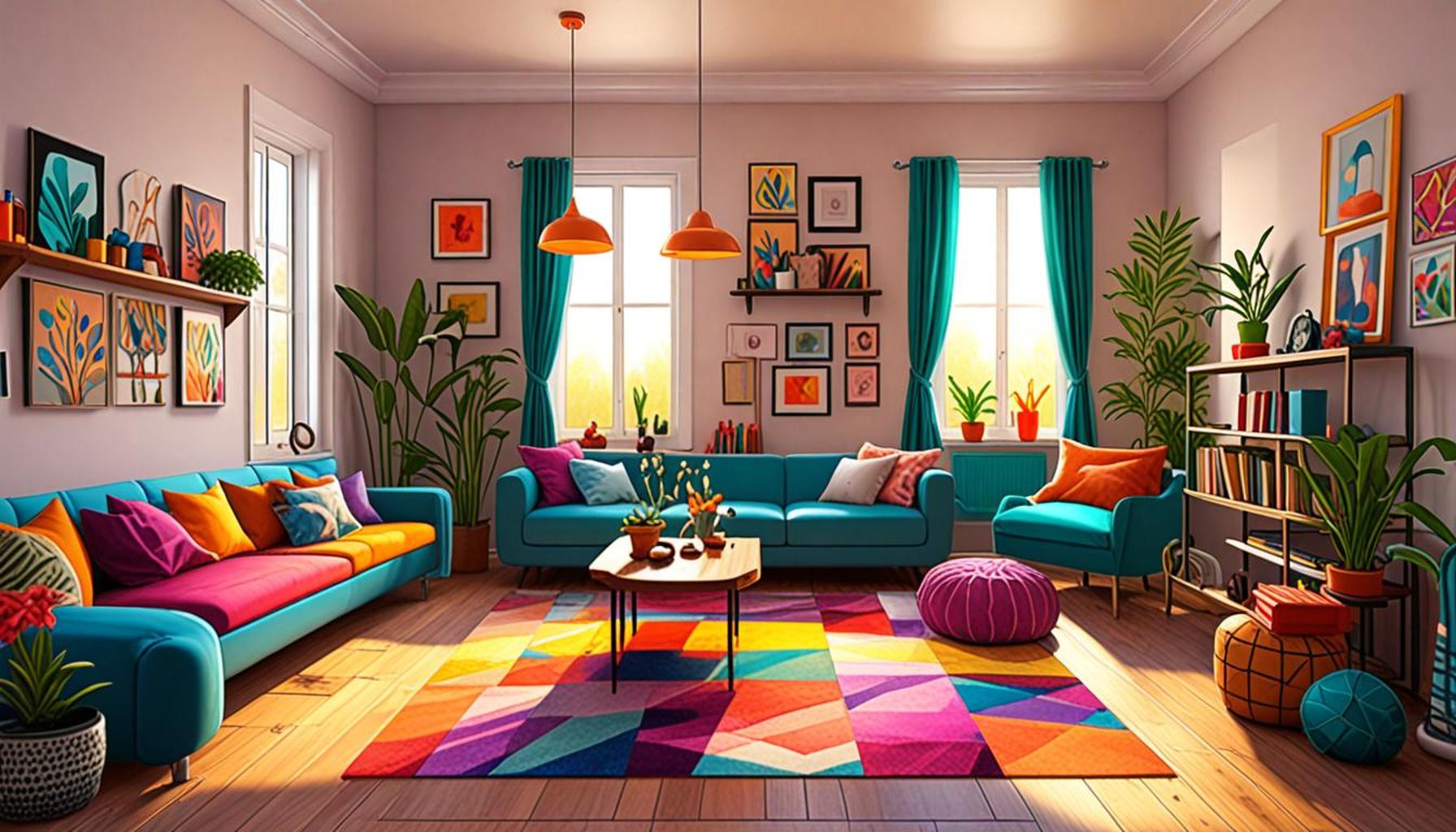Conscious Decisions: The Key to Creating a Harmonious and Functional Living Space

The Essentials of Designing Your Sanctuary
In a world teeming with commotion and endless distractions, creating a seamless blend of tranquility and practicality in your home is paramount. The choices we make in our living spaces not only reflect our personal aesthetic but also symbolize our core values, needs, and lifestyle preferences. By engaging in conscious decisions, we can shape our homes into a haven that harmonizes with our psyche and enhances our quality of life.
When creating a retreat within the walls of your home, consider several fundamental elements that can help foster a serene atmosphere.
- Color Palette: The colors surrounding you have a profound impact on emotional well-being. Shades like soft blues and greens inspire calmness, while warmer tones such as yellows can energize a room. In Nigeria, incorporating local colors such as earth tones inspired by the landscapes can evoke a sense of belonging and nostalgia.
- Furniture Placement: Thoughtful arrangement of furniture can enhance the flow within your space. For instance, positioning your seating to promote conversation not only encourages interaction but also creates an inviting atmosphere. This is especially relevant in culturally rich environments bustling with vibrant social ties.
- Natural Elements: Integrating plants, natural light, and earthy materials can ground your space. In a city like Lagos, where hustle and bustle reigns supreme, optimizing for more natural elements can transform your home into a green oasis that offers a breath of fresh air. Houseplants such as the resilient snake plant or pot plants indigenous to Nigeria can improve air quality and aesthetics alike.
Culturally, spaces in Nigeria are often reflective of communal values and individual identity. The layout of traditional homes may prioritize shared spaces, where family and friends gather to bond. By understanding these cultural nuances, you can weave together the rich tapestry of tradition with contemporary needs, creating a balanced living area that speaks to both heritage and modernity.
As you embark on your journey to crafting your ideal space, keep in mind the significance of every decision. Engaging in conscious decision-making empowers you to utilize colors, layouts, and natural elements to curate an environment that speaks directly to your values and aspirations. Each choice you make shapes not only your physical space but also your emotional sanctuary. By embracing this philosophy, you can create a living arrangement that fosters well-being, warmth, and an ever-present sense of home.
YOU MAY ALSO LIKE: Read read another article

Mindful Material Selection: The Foundation of Your Sanctuary
One of the cornerstone elements of creating a harmonious living space lies in the mindful selection of materials. The textures, finishes, and functions of what fills your home carry emotional weight and significance. When you make conscious choices regarding the materials you utilize, you can ensure they contribute positively to the overall atmosphere of your sanctuary.
Consider the durability and sustainability of the products you choose. In Nigeria, where the climate can be both humid and variable, opting for materials that withstand environmental stresses is crucial. For instance, local woods like mahogany or teak not only support sustainable practices but also inject warmth and authenticity into your décor. These materials breathe life, steering away from mass-produced, synthetic alternatives that often lack character.
Additionally, the tactile experience cannot be overlooked. Soft, tactile fabrics for cushions or throws can evoke a sense of comfort and welcome. Fabrics like cotton and linen, which are commonly used in Nigerian households, are not just practical for the hot climate but also allow the skin to breathe, enhancing comfort. Conscious decisions about the textiles you incorporate can lead to a more enjoyable sensory experience at home.
Integrating Functionality with Design
The essence of a functional space resides in its layout, impactfully influencing the way we interact within it. When arranging your home, think about how you and your family utilize certain areas. For example, in many Nigerian homes, the living room often doubles as a social space, making it essential for it to embody both style and practicality.
- Versatile Furniture: Consider selecting multi-functional pieces such as ottomans that serve as both seating and storage.
- Open Spaces: If possible, embrace a more open layout that allows for flexibility in movement, ensuring that everyone feels at ease.
- Designated Zones: Create zones within your space for different activities—reading, entertaining, or working—to cater to various needs without clutter.
The concept of functional design is closely tied to the social fabric of Nigerian culture, emphasizing the importance of gathering spaces that accommodate family and friends. By crafting areas that promote interaction, your living space becomes a reflection of your values, serving not only as a home but as a vibrant hub of connection.
Remember that each decision made during this process serves a purpose. Engaging in conscious decision-making empowers you to curate a sanctuary that embodies not just aesthetic beauty but also true functionality tailored to your lifestyle. As you invest in thoughtful material choices and design strategies, you weave a complex narrative of self-expression and belonging within your living space.
| Advantage | Description |
|---|---|
| Improved Well-Being | Making conscious decisions in your living space enhances personal well-being, contributing to a positive atmosphere that promotes relaxation and creativity. |
| Functional Spaces | Choices made with intention can lead to better functionality, ensuring that every area serves a purpose and reduces clutter. |
By incorporating the principles of conscious decision-making into your approach to home design, you can curate a living space that not only looks appealing but also serves your everyday needs effectively. This process requires consideration of how each object and element embodies your lifestyle and reflects your values. Whether it’s selecting sustainable materials or choosing colors that evoke tranquility, every choice counts in creating a harmonious environment that enriches your lives. As you start to embrace these principles, you will discover that transformation lies within the mindfully curated details of your space. Explore how the alignment of space with personal values can inspire deeper connections both within oneself and with others in this peaceful setting.
LEARN MORE: This related article may interest you
The Art of Color Psychology: Choosing Hues that Harmonize
The colors that envelop your living space play a significant role in shaping the ambiance and emotional response to each area. Engaging in conscious color selection is vital in establishing not just visual appeal, but also a serene and functional atmosphere. This is especially pertinent in Nigeria, a country celebrated for its vibrant culture, where colors often carry deeper meanings and significance.
For instance, warm hues such as yellows and oranges can foster creativity and sociability, making them ideal for family gatherings or playrooms, where interaction is encouraged. In contrast, cooler colors, such as blues and greens, can promote relaxation, making them suitable for bedrooms or reading nooks where peace is paramount. Engaging with the principles of color psychology allows you to select shades that enhance the overall mood and functionality of your space.
Incorporating traditional Nigerian color palettes can also serve as a beautiful tribute to heritage while ensuring your home resonates with a sense of belonging. Earthy tones, reminiscent of the rich landscapes of Nigeria, can create a grounded feeling, while splashes of bold accent colors can stimulate the senses and energize spaces. Conscious design decisions surrounding color usage can transform your living area from merely a shelter to a sanctuary that reflects individuality and culture.
Lighting: The Unsung Hero of Ambiance
Another vital aspect of creating a harmonious living space is the role of lighting, which often goes unnoticed but has a profound impact. Natural light, whenever possible, should be maximized; this not only reduces reliance on artificial sources but also instills a sense of vitality and connection to the outside world. The use of large windows or glass doors that open to courtyards can substantially brighten your rooms while offering visual continuity with nature.
- Layered Lighting: Combine various light sources, such as ambient, task, and accent lighting, to cater to different needs and moods throughout the day.
- Energy Efficiency: Choose energy-efficient bulbs that mimic natural light, promoting sustainability while lowering energy costs.
- Cultural Touches: Integrating traditional lamps, such as lanterns or woven light fixtures made by local artisans, can create charm while supporting local craftsmanship.
The positioning and type of lighting are just as crucial. For example, placing softer lights in relaxation areas can ease the atmosphere, while brighter lighting can help maintain focus in workspaces. By being mindful of your lighting arrangements, you directly influence how spaces are perceived and utilized, maximizing both functionality and harmony.
Finally, it’s essential to reflect on the emotional ties that certain objects hold within your living space. Items such as artwork, family heirlooms, or souvenirs from travels contribute not only to the aesthetic but also to an environment filled with stories and memories. Select pieces that resonate with you personally, ensuring that every item serves to enhance the narrative of your home while fostering a sense of belonging. Embracing conscious decisions in how you decorate can cultivate a living environment that is rich with meaning and fully encapsulates your essence.
LEARN MORE: This related article may interest you
Conclusion: Embracing Conscious Decisions for an Inviting Home
In conclusion, the journey towards a harmonious and functional living space is truly one of conscious decisions. By carefully considering elements such as color, lighting, and personal artifacts, you can transform your home into a sanctuary that resonates with both aesthetic beauty and emotional significance. The strategic use of color, informed by color psychology, allows you to curate an atmosphere that fosters well-being and reflects your personality and cultural heritage. In Nigeria, where colors speak volumes about identity and emotion, this aspect becomes even more integral.
Moreover, harnessing the power of lighting serves to enhance not only the practicality of a space but also its mood. By maximizing natural light and incorporating layered lighting techniques, you create environments that adapt to various needs throughout the day. Additionally, embracing local craftsmanship through lighting fixtures and decor not only supports artisans within your community but also infuses your home with unique charm and character.
Finally, the pieces you choose to display—whether they are treasured memories, art, or culturally significant objects—serve as personal touchstones that evoke warmth and familiarity. Each item contributes to the story of your life and the essence of your space. As you embark on the endeavor of reimagining your living space, remember that every conscious decision, no matter how small, contributes to a broader narrative about who you are and how you wish to experience the world. Therefore, take the time to reflect on your choices and create a living space that is not only functional but truly harmonizes with your spirit.



